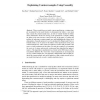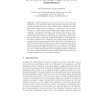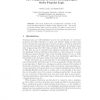333 search results - page 4 / 67 » On the complexity of partial order trace model checking |
SIGSOFT
2009
ACM
14 years 8 months ago
2009
ACM
We propose a new algorithm for verifying concurrent programs, which uses concrete executions to partition the program into a set of lean partitions called concurrent trace program...
CAV
2009
Springer
14 years 8 months ago
2009
Springer
Abstract. When a model does not satisfy a given specification, a counterexample is produced by the model checker to demonstrate the failure. A user must then examine the counterexa...
CONCUR
2000
Springer
13 years 12 months ago
2000
Springer
Model checking based on the causal partial order semantics of Petri nets is an approach widely applied to cope with the state space explosion problem. One of the ways to exploit su...
SPIN
2005
Springer
14 years 29 days ago
2005
Springer
We describe an improvement of the partial-order reduction algorithm for breadth-first search which was introduced in Spin version 4.0. Our improvement is based on the algorithm by...
MFCS
2005
Springer
14 years 1 months ago
2005
Springer
This paper analyses the computational complexity of the model checking problem for Higher Order Fixpoint Logic – the modal µ-calculus enriched with a typed λ-calculus. It is ha...



